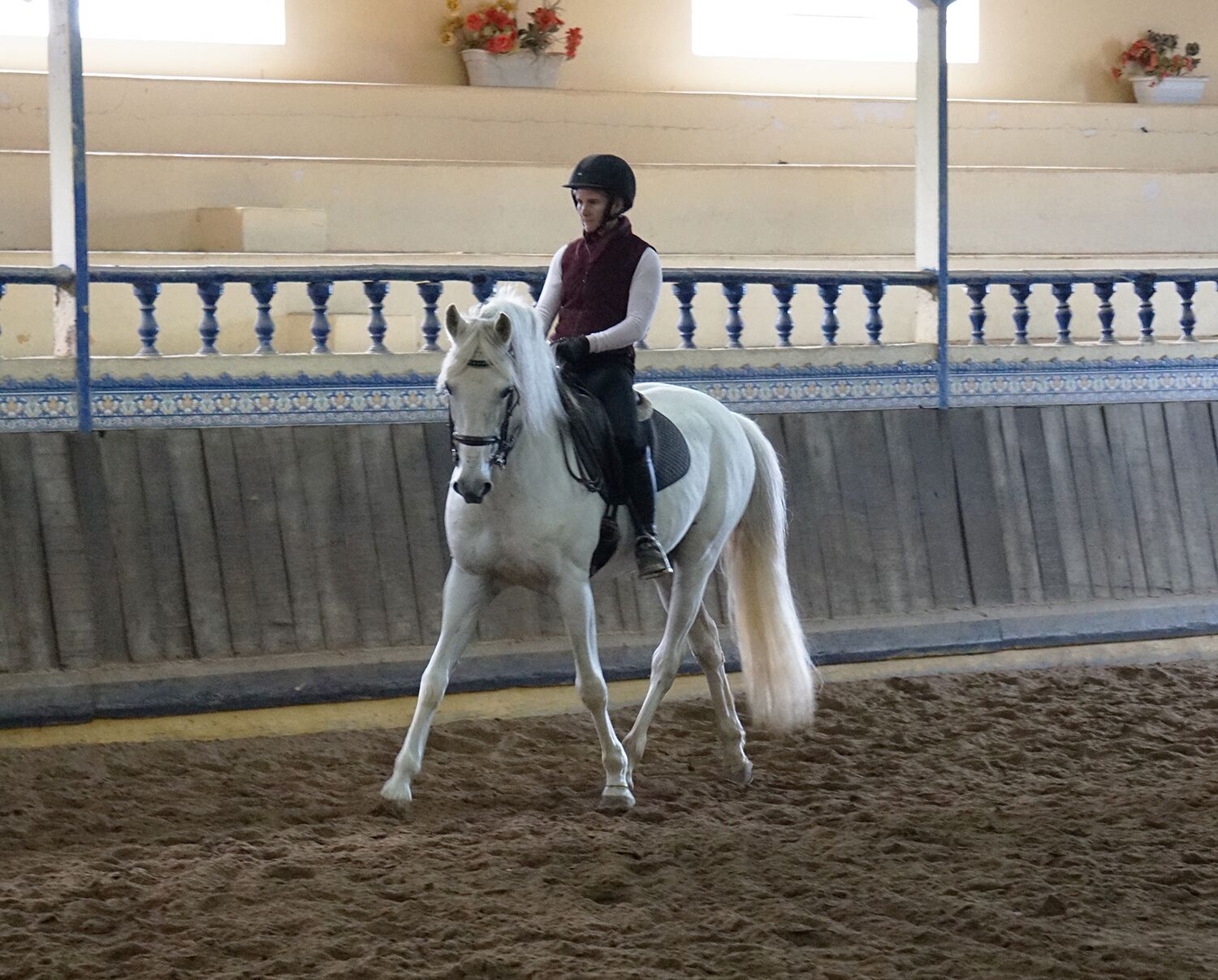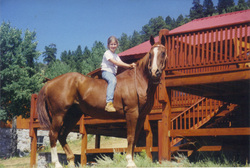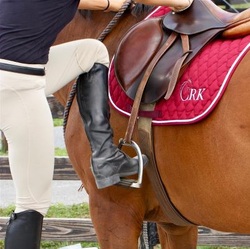The sitting trot is a difficult gait for many to learn. It is not a gait you can muscle through, in fact the more you try to hold yourself in the saddle by gripping tighter the more you will end up bouncing.
The more you bounce on the horse’s back the more they will tighten their back for protection, in effect shortening their stride and making the gait even more difficult and uncomfortable to ride.
To ride the sitting trot well requires a few key skills of alignment and movement. In this video I’ll show you what those skills are, and more importantly, a simple exercise for practicing this gait that will help you learn without the bouncing.














62 Responses
Thank you! I am an older rider,(65), that needs a lot of limbering up when I ride. I appreciate the tips of flattening my back, allowing my hips to open, (takes a bit of stretching), and my thighs to bear the weight. The walktrot transitions tip is a big one! I tend to pullback on the reins so concentrating on keeping my hands forward will take some practice! So grateful to have found CRK Training!
As usual, you break down all the necessary information needed to perform the sitting trot and other difficult skills. All the questions in my mind get answered in your videos. You’re a great instructor and address the adult mind. (I find that most trainers gear their instruction toward the young learner.) As an older rider (soon to be 73) back from a 45 year hiatus and a hip replacement 2 years ago, I seem to require details and you do that so well. Thank you so much for these great tips in working with these beautiful, sensitive animals.
Hi Callie
Thanks for all your great videos! It is such a long time ago that I learned sitting trot that I have forgotten how I finally got there, but all I would say to others is that what Callie says about relaxing the glutes is absolutely key. For me, riding bareback, or going without stirrups and lots and lots of practice really helped, and I suppose it is a circle of relaxing, going with the horse’s movements and believing that you can do it, which helps you relax, go with the movement, etc etc. Hopefully that makes sense!
Ecellent! Great break-down and awesome explanations as o why. You’re videos are always good, but I’m thinking this one definitely makes he top 10 🙂
Thank you, Callie! I can’t wait to put your instructions into practice, hopefully this afternoon. I’ve just returned to riding at 56, though I don’t seem to remember anything useful from my 2 teenage summers spent riding. I rode just at a walk, bareback, in January, with a goal of learning the sitting trot this month. Do you think I need a saddle to practice these exercises properly? I do have access to one, but it’s very large and heavy. I plan to locate a properly sized Western saddle when I’m comfortable riding bareback at walk, trot, canter – but I can move that up as a priority if need be. (The bareback as stage one plan is my own idea, based on problems handling the available saddle and the fact that I rode bareback as a kid).
You addressed the exact topic I was looking for. Thank you!
Colleen, you can learn to ride these gaits bareback however I would caution you for two reasons. The first is that riding bareback is difficult on a horse’s back for extended periods of time, research has shown that periods of bareback riding longer than 20 minutes can cause damage. The second issue with riding only bareback is that when you do sit in a saddle it can be difficult to adjust to having to work in the constraints of the stirrup.
Hope this helps!
-Julia Burdy, CRK Training Community Manager
The best thing I found was to ensure my back is ‘filled’, i.e. not hollow. Then things just seemed to follow on from that. As I have a tendency to hollow my back, this is the main thing I look out for – and boy, what a difference it makes. But I do practise when I am just sitting at home, or sitting in the car. Thanks for putting it all so simply, Callie – such an approach is very encouraging.
Enjoy your videos, so informative, easy to understand and good reminders to keep riders on task. I to am an older rider (67) and last year I had lower back surgery. I found building a strong core helps keep my back straight and better supported. Regular excercise and strengthening is very important especially for us older riders and for our horses. Look forward to next weeks video.
Sheila,
Be careful not to be holding your core too tight when trying the sitting trot, too much tension in the abdominals really affect the horse’s movement and our ability to function as a rider!
-Julia Burdy, CRK Training Community Manager
I am finding myself doing this, stomach muscles feel sore! Do you have any tips to stop this please?
Oh Kay, you can relax your stomach muscles! Tightening your core causes unnecessary tension!
-Julia Burdy, CRK Training Community Manager
Im also a fairly new and older rider (64) and appreciate the simple steps you give!
I have found that keeping my hands forward, relaxing and avoid bracing by opening up my hip angle has helped me tremendously. When I relax, my horse does too!❤
This was a wonderful straight forward video with clear instruction and advice. My issue with sitting trot is with the posting/sitting transitions. I can sit the trot when I start trotting, but once I post and then try to sit the trot I’m bouncing all over the place. Any advice?
I too am an older rider (soon to be 66).
Thank you in advance.
Roberta, it is difficult to say without seeing however it sounds like you begin to grip or have tension in the posting trot and then when you return to the sit trot it becomes more apparent!
-Julia Burdy, CRK Training Community Manager
Best information I’ve received was yours and Wendy Murdoch’s advice for “knees move forward and down”. So instead of bouncing up and down, my body moves forward and down at the knees. This was ride changing!
Looking forward to trying this today!!! Have had so many changes with Maverick, but he is finally sound, can be in consistent work, so now it’s my turn to hopefully find a consistency to offer him;~} Flat, full back is something, of course, I still need to focus on, as he quickly hollows out and lifts his head…but 2 or 3 trot steps is a reasonable goal. I am also working with him on position 1 from Patrick’s course…he yawns like crazy every single time he telescopes his neck and head, he has so much junk up there in his occipital area…so hoping that he finds more and more release of his tension…someone recently described him as an ADHD type, so busy….but we are making progress I sure hope and believe…x
Awesome! That in hand work will help him learn to balance himself for the ridden work!
-Julia Burdy, CRK Training Community Manager
Learning to relax my leg has made all of the difference.
I have found that if I breathe into the sides of my rib cage and then out into my seat
It is much easier to do a sitting trot. My horse is more willing also and relaxed.
I also practice flat flat back and no bracing on the stirups. Since I ride western my horse has a loose rein.
I teach it to my students just like you taught it in this video. A few steps at a time, then a few more. Relax and breath in between. Try to continue relaxed breathing at the trot. And as you, Callie, taught me in a lesson one day I have them put the reins in one hand and press their lower back into the back of their other hand. I have one who leans forward just thinking about (not even yet doing) a trot. This helps her to keep her upright posture much better. I try to do this on occasion myself as I lean, too, because of my back issues. And it definitely feels better when my back overall is more upright.
Callie I like your idea of trot a few steps then walk and repeat. Will definitely give that a try as I feel I still bounce too much.
One question, in a trot I’ve been taught to move with the horse so my hips are thrusting forward and back with a one two count. How is it I didn’t see that movement with you? Your hips looked to have very little movement.
Jane, it may be too much movement from your seat – however some of that might depend on how big the horse’s movement is! The important thing to take notice of is that your knee is moving forward and down with each stride.
-Julia Burdy, CRK Training Community Manager
Hi Callie I really enjoy your training videos. You have a wonderful manner of teaching and explaining. Just wish I could have you in my ears whilst riding – long distance lessons to Australia!
Lyn, you can! We offer several online programs, click here to see what we offer. In our Balance Riding Course program we have Audio Lessons, which you can use while riding to have Callie literally in your ear!
-Julia Burdy, CRK Training Community Manager
Callie, you are my favorite instructor by far! Your videos are very helpful and informative. I have a 16hh retired standardbred pacer who was never really trained to trot and I was told cannot cantor. His trot is a big bumpy one! I will be practicing the sit trot this weekend and following your advice!
Awesome! Let us know how it goes after you get some practice time in Jacqueline!
-Julia Burdy, CRK Training Community Manager
The trot used to be my most dreaded gait, now it is my favorite. I think what helped me the most was relaxing my legs and thinking of “kneeling on the horse” instead of gripping with my legs. That picture in my brain is also what helped me with learning to post the trot too. If I remember right, the concept of “kneeling on the horse” also comes from Angelo Telatin.
Katrina, the ‘kneeling’ visual is fantastic for getting the feeling of the seat and leg position!
-Julia Burdy, CRK Training Community Manager
Learning to trot bareback has helped me improve the most, and as alsways breathing in rhythm with the horses movement is a big help.
Thanks for sharing these great tips Tina!
-Julia Burdy, CRK Training Community Manager
Can you please describe how you transition from trot to walk. Do you use one rein or two? Do you just squeeze your fingers in your inside rein and leave your outside rein loose, or do you use two reins or do you slow your movement down?
Lizll, the trot to walk transition can be simply thought of as slowing the motion into walk – we have a video on transitions, click here to watch!
-Julia Burdy, CRK Training Community Manager
My biggest “aha” came when I sat on Callie’s bouncy “mechanical” horse. Reminded me of the toddlers’ spring-bounce horse but really brought home the feel of going up and down with the horse.
Alla, you are the second person who has mentioned that Joker was their key to riding the sitting trot correctly!
-Julia Burdy, CRK Training Community Manager
Mine was similar, though with an exercise ball. I practiced Wendy Murdoch’s “knees forward and down” while sitting on the ball and moving it forward by slightly lifting it with my calves and seat as if posting but not rising. I think this also encourages my horse to lift his back during the slight rise.
What helped me the most with sitting trot was and is – riding without stirrups. This gave me no choice but to relax my legs. Also, thinking about making my legs longer and keeping my heels down without stirrups has improved my position immensely.
Wendy Murdoch had an article in Eclectic Horseman Magazine (I think that’s where I saw this) for sitting the trot. She asked you to first sit one stride, as changing diagonals. Then two strides, etc. Of course, all the things you stressed also had to be happening-flat back, relaxed legs, no bracing in the stirrups. Thank you for all the information you put out in video form!!
Beverly, yes – that is another great exercise for working on the sitting trot 🙂 Wendy recommends that one in her Effortless Riding Course!
-Julia Burdy, CRK Training Community Manager
Thankyou as usual the video was absolutely brilliant can’t wait to try it out at the new stables
where I ride now – I used to ride a fabulous horse and the sitting trot seemed to come easy with her
so I will try to remember the lesson with the new horse
Hi Patricia – hope these tips help with your new lesson horse 🙂
-Julia Burdy, CRK Training Community Manager
Great video. Fortunately my horse has an amazing slow trot that is very easy to sit. We say he is like riding a sofa as he is wide and very smooth. Almost floats. Helps many learn to sit the trot.
Patricia, that is awesome! Makes learning the sitting trot much easier 🙂
-Julia Burdy, CRK Training Community Manager
Love your helpful videos. Will you tell me what saddle brand / model you are using? Thanks!
The saddle is a Lauriche jump saddle made by AJ Foster.
-Julia Burdy, CRK Training Community Manager
Yes I agree the way to learn to sit the trot is to literally go with the movement of the horse. To me it’s all about being connected and keeping legs in full contact as well as your seat.
Thanks Callie, will be trying that! I too am an older rider and stiff in the hips so can find sitting trot hard. The other day I did a long session of it in my lesson; the instructor and an observer were both ‘wow, you and your horse look amazing, can you feel that?’ but I actually just felt sick (like motion sickness) when I stopped. Any advice please?
Hi Kay, it is hard to say exactly why you were feeling that way but I would recommend shorter sessions if you find yourself getting light headed.A Also, if you can pick one point on the rail to focus on with your eyes that can help with dizziness.
Hope this helps!
-Julia Burdy, CRK Training Community Manager
That’s so helpful. My cob is bum high so on the forehand with a rather straight forward shoulder so sitting trot isn’t very comfy add to that sub conscious protection of lower back problems from years ago it’s not a good recipe for sitting trot. With your help l’ve realized we can manage a few strides before we both get tense. Great. Your description of what to do with what part of you leg is really helpful. I enjoy your videos loads of info. Brilliant.
Awesome Melanie – I’m glad to hear that this video has been beneficial. Keep us updated on your progress 🙂
-Julia Burdy, CRK Training Community Manager
Great ideas, looking forward to practicing. What is helping me right now is taking lessons on a thoroughbred. My standardbred has a very powerful trot with a huge lift. I don’t know if I will ever be able to sit it, although I am told it is possible!
Thanks again Callie, love your stuff.
Isis
Callie, once again thank you for a wonderful lesson. Could you please clarify for me the idea of taking weight on the thighs? Does the weight go down the front? the back? I have never heard this before, And I confess that when I tried to implement it, I found what I was doing seemed more like gripping than weight bearing. Thank you so much.
Anna, I think the best description of this feeling comes from Sally Swift’s Centered Riding – the leg should feel like a slab of raw meat. Think of your leg with that tone on the saddle and instead of the pressure being on the stirrup only having the weight distributed on the seat and thigh.
I hope this helps!
-Julia Burdy, CRK Training Community Manager
Hi Anna, I find it helps to think I am trying to stretch my thigh as if I was trying to push my knee a bit forward and down on the saddle flap. I know it is impossible to change the length of your thigh but it is as if you were trying to make it longer. That stretch should cause mild pressure on the saddle but definitely not an inward gripping pressure. Try it at the walk and see how it feels. I hope I haven’t confused you even more.
Hi,
Thanks for the video. Could you clarify for me the difference between sitting trot and rising trot? Why do we have 2 types of trot?
Thank you
Ezgim, in the sitting trot we are doing just that, sitting the trotting gait of the horse while in the posting (or also referred to as rising) trot we leave the saddle as one of the forelegs of the horse reaches forward!
-Julia Burdy, CRK Training Community Manager
Hello, I am an advanced beginner rider and I am horse shopping. I had a trainer tell me today that posting the trot is the worst idea ever and that people should never post the trot because it leaves them open to have the horse throw them. Aka when your seat and thighs leave contact with the saddle you have less stability, the horse can feel that, and can then time it just right to throw you. I was wondering your thoughts. I have learned how to post for the start of my lessons. Thanks.
Hi Amber, I don’t believe that you are more vulnerable when posting to the trot. It would be a very rare horse that would actually be trying to get you off in the first place and if you stretch down through your calf and keep your heel down you will be quite stable on the horse. Happy horse hunting, take the time you need to find the right one for you.
Well, it doesn’t hurt that I learned sitting trot on a Saddlebred who has an amazingly smooth trot and lovely “jog”. A jog is easier because it’s slow, but even at a decent rate, the trot’s pretty smooth. That said, it did not come immediately to me. I had to learn to let my hips stay loose so that my body moved more with the horse than against it. Very nice well-explained video!
Hi:
I love watching your videos. I am a senior rider (therapeutic) so I am not very good. (Still feel nervous when I fell off a horse years ago).The horse I ride does not listen to me (she is very gentle). But I am not firm enough. She will only listen when she sees the owner coming. Callie -you making riding look so easy – but it is really hard. You are a terrific rider – and you have a nice horse. I know I won’t be a good rider – but I really feel happy when I go riding.
Mary Fyke
Mary, thanks for being part of our community! I have a few resources I’d love for you to check out – the first is the Power of Positive Learning (from your comment I think you are a little hard on yourself!), also the free training from our Calm and Confident Rider program. This training will help you with the fear and anxiety you are feeling in the saddle!
Happy Riding,
-Julia Burdy, CRK Training Community Manager
Excellent video. My sitting trot is improving. …In the transition,
from trot to walk……do I loosen the reins and say “easy walk”.
When I want to trot I say “ho”. We stop……I rub his neck. Then
I give a squeeze with my calves and say “trot” and off we go. Is this
correct? Please advise and thanks!
Glenn, if he responds then that is the important part! The key in the transitions is to having them crisp and clean that he is responding to what you are asking!
Hope this helps!
-Julia Burdy, CRK Training Community Manager